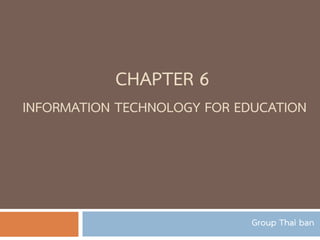
Chapter 6
- 1. CHAPTER 6 INFORMATION TECHNOLOGY FOR EDUCATION Group Thai ban
- 2. Member 1. นางสาวจินตหรา ขันเพียแก้ว 2. นายธวัตรชัย เดนชา 3. นางสาวนลินทิพย์ วงษาพัด 4. นายเมธี สาระดา 565050267-6 565050271-5 565050275-7 565050282-0 เอกการสอนคณิตศาสตร์ เอกการสอนคณิตศาสตร์ เอกการสอนคณิตศาสตร์ เอกการสอนคณิตศาสตร์ 5. นายลิขิต จิตโส 6. นายกลวัชร การแก้ว 7. นางสาวดารานิล นิรงบุตร 8. นางสาวพัชราภรณ์ ชัยเสนา 565050321-6 565050325-8 565050329-0 565050334-7 เอกการสอนเคมี เอกการสอนชีววิทยา เอกการสอนชีววิทยา เอกการสอนชีววิทยา
- 3. Mission 1 Analyze the role and importance of information technology to improve education, according to education reform.
- 4. The role of information technology and Educational development based approach to education reform. 1) 2) 3) Technology is essential to assist in learning. Technology into Support education. Technology to assist in communication between individuals in education. Computer Assisted Instruction (CAI)
- 5. The importance of information technology and Educational development based approach to education reform. 1) 2) 3) Help to organize content for learning . Help to increase the efficiency of production information such as complex numerical calculations, Sorting of Information, etc. Enable the storage of information in a form that can be used at any time easily.
- 6. The importance of information technology and Educational development based approach to education reform. 4) Enable automated systems to store, process and retrieve information. 5) Help to access information quickly and more efficient. 6) Helps to communicate quickly and easily reduce the barriers of time and distance by using phone systems, etc.
- 7. Mission 2 Analyze methods to apply information technology to administer learning focused on Student-centered.
- 8. การนาเทคโนโลยีสารสนเทศมาประยุกต์ใช้เกียวกับการศึกษาเพื่อสนับสนุนการ ่ เรียนรู้ของนักเรียน ทีจะเป็นประโยชน์สูงสุดต่อนักเรียน ดังนั้น การนาเทคโนโลยีมา ่ ใช้ในห้องเรียนจะต้องเริ่มจากวางใส่เข้าไปในตัวหลักสูตรและแผนการจัดการเรียนรู้ ตัวอย่างเช่น Learning process Learning activities Media sources Introductions Connecting prior knowledge 1. Determine questions / discussion to new knowledge. about prior knowledge of the learner. 2. Purpose clarification The learning Video Power point, Internet
- 9. The application of information technology in education. Computer Assisted Instruction: CAI E-books E-library E-learning
- 10. Caution in the use of technology in the Learning Management. Program design is actively use of time and talent. Teachers should have knowledge about information technology appropriately. Limitations or the suitability of using technology for learning. Can not convey the feeling of truly learning.
- 11. Mission 3 You consider the use of information technology to optimize learning . Context of schools assigned to the following. Reasoning and illustration .
- 12. Ban Nongnguhao School Located in remote rural area. The school have three-computer and a television but no phone signal.
- 13. Choosing to use technology to enhance learning management to efficacy. We choose : video media and Computer Assisted Instruction. Because Ban Nongnguhao school located in remote rural areas. The school have three-computer and a television but no phone signal. Using video media, which consists of animations, sounds, etc. to use in teaching. Moreover, the used of Computer Assisted Instruction , students can also use various computer programs to help them learn and develop their potential.
- 14. Hisobetong School Located in the city. The school have computer room, media , technology and high-speed Internet. There are not enough teachers because they move away of the unrest.
- 15. Choosing to use technology to enhance learning management to efficacy. E-learning E-books
- 16. Choosing to use technology to enhance learning management to efficacy. Computer Assisted Instruction : CAI Web-Based Learning
- 17. reasoning Because the school can use the Internet and computer thus, it can use the Internet to promote self-learning without a teacher.
- 18. THANK YOU
